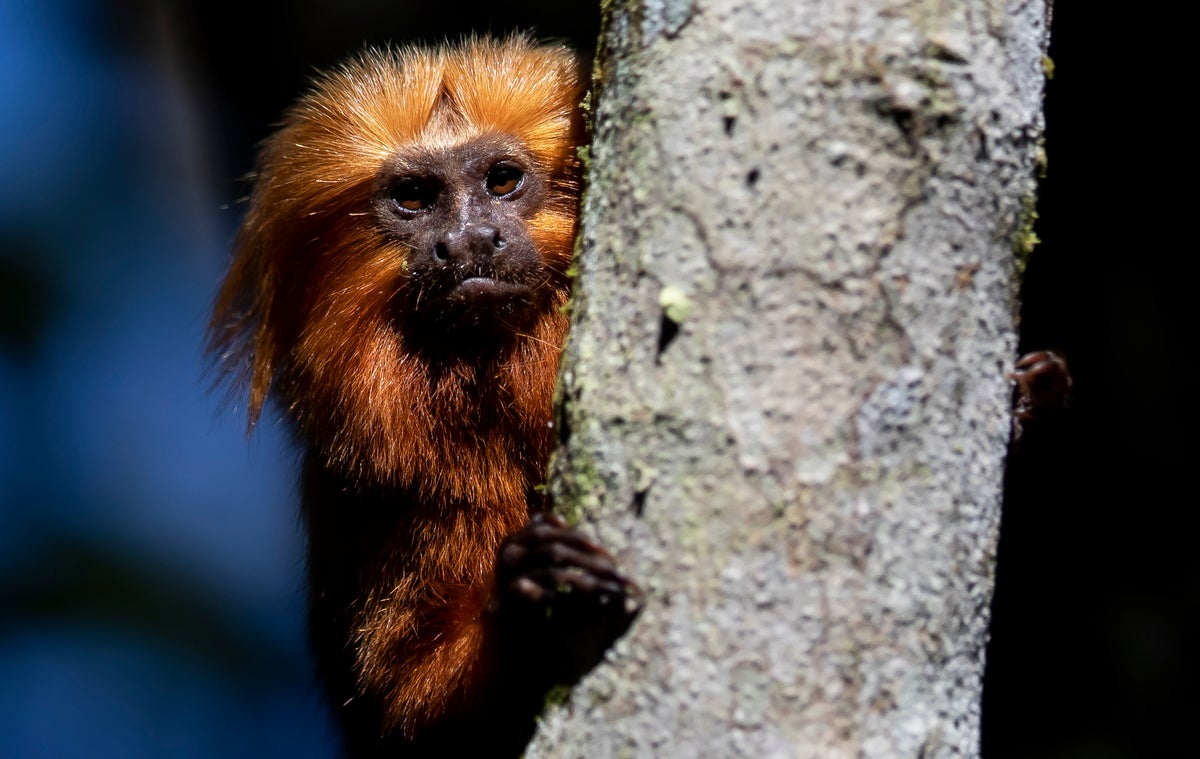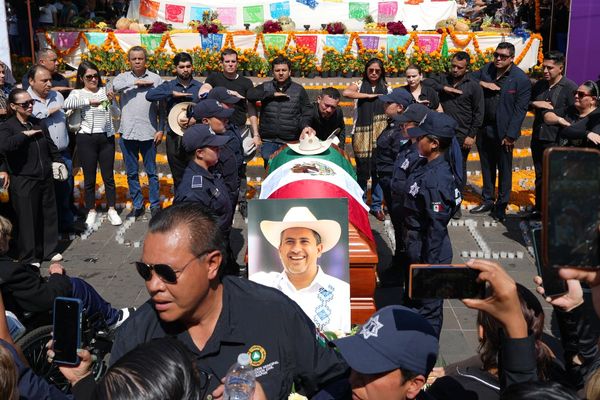
In a small lab nestled in Brazil’s Atlantic Forest, researchers with gloved hands and masked faces cradle four tiny golden monkeys so a veterinarian can delicately slide a needle under the thin skin of each sedated animal’s belly.
The next morning, biologist Andréia Martins brings them to the precise spot where they were caught. She opens the wire cages and the monkeys dart out, hopping to a tree or the ground, ascending the canopy and regrouping as a family. They chatter noisily as they vanish into the rainforest.
This brief, strange encounter with humanity has been for the sake of their own health – and the survival of their kind. These endangered wild monkeys, called golden lion tamarins, have now been vaccinated against yellow fever, part of a pathbreaking campaign to save a threatened species.
“Vaccinating wild animals for the sake of animals, not to protect humans, is novel,” said Luís Paulo Ferraz, president of the nonprofit Golden Lion Tamarin Association.
When yellow fever began to spread in Brazil in 2016, resulting in more than 2,000 human infections and around 750 deaths, it also quickly killed a third of the highly vulnerable tamarins, the majority of them in just a few months. So scientists in Brazil customized a yellow-fever vaccine for the endangered monkeys.
The inoculation campaign started in 2021, and already more than 300 tamarins have been vaccinated. The first such effort in Brazil — and one of the first worldwide — it raises vital questions about how far to go to save a species from extinction.
One of the traditional adages of conservation is “Leave it be.” But in an age when every corner of the globe is touched by human influence – from melting icebergs to fragmented forests to plastic-filled oceans – a new generation of scientists and environmentalists is increasingly calling for more interventionist approaches to save wild animals and ecosystems.
“There are people who say we shouldn’t touch nature, that we shouldn’t alter anything. But really, there are no pristine natural habitats left,” said Tony Goldberg, a disease ecologist and veterinarian at the University of Wisconsin-Madison, who supports vaccinating wildlife when it’s safe and practical. “People are waking up to the magnitude of the problem and realizing they have to do something.”
Carlos R. Ruiz-Miranda, a conservation biologist at State University of Northern Rio de Janeiro, is among the scientists who have worked for more than three decades to protect the golden lion tamarins, twice going to their rescue when extinction threatened. He says the vaccinations are the only option left: “Is it too extreme? Give me another alternative.”
“We have to intervene when it’s a human-borne conservation risk, if you’re going to have an environment with wildlife,” said Ruiz-Miranda.
Viruses have always abounded in nature. But humans have drastically changed the conditions and impacts of how they spread in wildlife. Epidemics can travel across oceans and borders faster than ever, and species already diminished by habitat loss and other threats are more at risk of being wiped out by outbreaks.
“Human activity is absolutely accelerating disease spread in non-human populations,” said Jeff Sebo, an environmental researcher at New York University, who was not involved in the Brazil project.
But there are risks. It’s tough to decide which species get the attention and resources needed for survival. In Brazil, a political climate of anxiety about the COVID-19 pandemic and misinformation about vaccines in general has caused delays. Yet if the scientists get it right, they could be pioneers to show what’s possible to save threatened wildlife.
___
The story of the golden lion tamarins is an epic saga – one that Marcos da Silva Freire, a longtime Brazilian health official, has experienced firsthand.
When Freire was a child in the 1960s, he spent weekends at his family’s property in the Atlantic Forest. But he never saw golden lion tamarins.
Around that time, Brazilian primatologist Adelmar Faria Coimbra-Filho first raised alarms about the shrinking population of the tamarins. Habitat loss and poaching for the pet trade had reduced their numbers to as low as 200 in the wild.
Southeastern Brazil was once covered by the rainforest, but today the undulating landscape is an uneven checkerboard of dark green jungle and grassy cow pastures – only 12% of this rainforest remains.
Yet it’s the only place in the world that wild golden lion tamarins live.
The effort to save the charismatic monkeys – famous for their copper-colored fur and small inquisitive faces framed by silken manes – led to a pioneering captive breeding program, coordinated among around 150 zoos worldwide, including the Smithsonian National Zoo in Washington, D.C. Many of those animals were then carefully released in Brazil starting in 1984, in cooperation with local landowners.
When Freire’s father, a landowner, was approached by researchers, he told them to coordinate with his son, then a veterinary student in his mid-20s.
On a clear July morning, Freire walks along a dirt road on his property, shafts of light splintering through palm fronds. “The first monkeys were released near here, behind that hill,” he said, pointing from the shore of a small lake, recalling the afternoon nearly 40 years ago.
He smiled when he saw some of their descendants, two monkeys scampering along a swaying vine. They jumped to a high branch, and soon vanished into a kaleidoscope of green.
Reintroduction was a learning process, for both the scientists and the monkeys, he recalled. Usually it was the second generation, not the first, that learned to be successful again in the wild.
Thanks to that effort – and subsequent campaigns to replant and connect parcels of rainforest – the population of tamarins slowly recovered, reaching around 3,700 by 2014.
But any celebration was premature.
___
One misty winter morning, Andréia Martins pulled on a camouflage jacket, rubber boots and a face mask, and tucked her machete into her belt. She followed a narrow path through the rainforest, stopping periodically to whistle in imitation of monkey contact calls.
Martins has been tracking golden lion tamarins in the rainforest for nearly forty years. The longtime biologist for the Golden Lion Tamarin Association can spot the tiny shimmer of golden fur among a green canopy and recognize more than 18 distinct vocalizations – from the specific calls of alpha males to their mates, to varying sounds to alert young monkeys to different types of food and predators.
On this trek, she recorded the noisy encounter between two monkey families, a dozen or so animals chattering loudly to proclaim territory.
It’s because of her patient fieldwork, recording detailed population data for four decades, that researchers were even able to track how many tamarins were killed by the yellow fever virus when it began circulating.
After the first lab-confirmed death of a tamarin from yellow fever in 2018, her team’s census revealed the population of wild tamarins had dropped from 3,700 to around 2,500.
Inside the Poço das Antas Biological Reserve, one of the largest tracts of continuous forest they inhabit, the death toll was even steeper: A population of around 400 tamarins dropped to just 32. “They just weren’t there anymore,” she recalled.
The tamarins had fallen victim again to human encroachment. From the top of a wooden watchtower, it’s possible to see swathes of replanted rainforest, as well as the newly expanded BR101 highway bringing a steady stream of traffic into the region.
“This epidemic moved very quickly from north to south, across the country – no wildlife does that,” said Ruiz-Miranda. “It’s people. They cross vast distances in buses, trains, planes. They bring the disease with them.” Yellow fever is transmitted by mosquitoes, he explained, but highly mobile infected people spread the disease much farther and faster than insects alone.
“We lost 32% of the wild population. It was a tragedy – it showed us how vulnerable this small population is,” said Ferraz, of the nonprofit Golden Lion Tamarin Association.
“We realized that in five years, we could lose the entire population if we did nothing.”
___
By a twist of fate, Marcos da Silva Freire had gone on to specialize in viruses. At the time of the yellow fever outbreak, he was a deputy director of technological development at Brazil’s Oswaldo Cruz Foundation, which oversees vaccine diagnostics and production in the country.
Conservationists who had toiled for decades to protect the monkeys were sharply divided over whether to vaccinate them. Some were hopeful the virus wouldn’t impact the monkeys; others worried that any kind of novel intervention would be too risky.
But Freire decided to test an idea. He arranged with the Primate Center of Rio de Janeiro to begin trials of different doses of yellow-fever vaccines on about 60 monkeys, close relatives of the tamarins, in January 2018.
A year later, he checked the level of antibodies in their blood – the vaccine appeared to work, without negative side effects.
Freire started to draw up a plan for the tamarins. “The idea is to vaccinate 500 animals,” he said. “For 150 animals, the goal is to vaccinate, then collect blood samples later – to test the safety and efficacy.”
The biologists had already honed a technique for luring the wild monkeys into baited cages. "It sounds like a cliche, but monkeys eat bananas," said the scientist Ruiz-Miranda.
But seeking official permissions for something that had no precedent in Brazil, vaccinating a wild species, was not a simple process. And then COVID-19 hit.
When the team finally got government approval to begin vaccinating wild monkeys, Freire supervised the first rounds of shots.
So far, they’ve vaccinated more than 300 tamarins and detected no adverse side effects. When they’ve caught and retested monkeys, 90% to 95% have shown immunity -- similar to the efficacy of human vaccines.
The outbreak appears to have subsided, and the monitored monkey population has stabilized overall and even increased a little inside the Poço das Antas Biological Reserve. And now the golden lion tamarins have a better shot at surviving as symbols of the Atlantic Forest.
___
While authorities elsewhere have inoculated animals to safeguard human health – vaccinating feral dogs and wild animals such as raccoons for rabies and other diseases – it’s still very rare for scientists to administer vaccine injections to directly protect an endangered species.
There was the campaign to vaccinate endangered Hawaiian monk seals against a strain of morbillivirus, launched in 2016. And rabies vaccines have been administered orally, hidden in food, to the endangered Ethiopian wolf and a few other species.
Martin Gilbert, a wildlife veterinarian and epidemiologist at Cornell University, has studied another potential vaccination campaign by modeling the number of Amur tigers in Russia that would need to be inoculated to provide protection against canine distemper. “Infectious diseases are presenting a conservation threat to wild species, and these are only going to increase as populations become more fragmented and isolated,” he said.
Of special concern are cases when encounters between humans or domestic animals and wildlife directly pass diseases to threatened species, as with respiratory diseases and great apes. Several studies have shown that chimpanzees that live near human settlements have higher rates of multiple diseases.
“There’s a great debate now about whether it’s a ticking time bomb before wild great ape populations get infected with COVID, and it sweeps through groups and kills many apes,” said the University of Wisconsin-Madison’s Goldberg.
Still, other scientists urge caution for any kind of new intervention.
“What are the unintended consequences of vaccination? You can’t always be certain,” said Jacob Negrey, a biologist and primatologist at Wake Forest University’s School of Medicine. “That would be my major hesitation – have we adequately controlled for every last variable?”
James Dietz, a biologist and president of the U.S.-based nonprofit Save the Golden Lion Tamarins, was initially wary of the vaccination campaign in Brazil. “When we choose to vaccinate wild animals against a disease, we may be giving them an advantage over non-vaccinated animals – and by doing that, we are acting potentially against natural selection that would, over time, be acting to improve the genetics of the species,” he said.
But in the end, he overcame those hesitations. “It was only when I realized the scope of mortality that I realized we had to do this,” he said. “And I’m very happy with the direction we took.”
There are other reasons to be cautious. While golden lion tamarins are tiny – weighing less than 2 pounds – and can be lured into cages with banana bait, it’s harder with large carnivores. “It’s exceedingly difficult to capture wild tigers and provide a vaccine,” said Dale Miquelle, who leads the global tiger program at nonprofit Wildlife Conservation Society.
Still, his organization recommends that “for small and highly vulnerable populations, it’s a good idea to do vaccinations” against canine distemper. No one has tried yet.
In Australia, scientists have applied for permits to begin a field trial of vaccinating wild koalas against chlamydia, which infects up to 80% of animals in some populations, causing death and lowering fertility.
The potential downside? “Catching koalas is really stressful on the animals,” said Samuel Phillips, a biologist at Australia’s University of the Sunshine Coast. “It’s a fine juggling act between causing stress on them and trying to help.”
But increasingly, he and other scientists feel that through habitat loss and other environmental changes, “We have decreased their population so much that it’s already at a critical point.”
His conclusion: “We need to do more to help them survive.”
___
Follow Christina Larson on Twitter at @larsonchristina.







